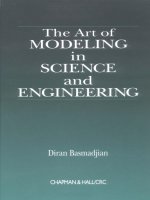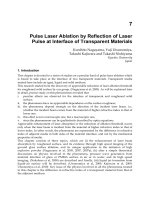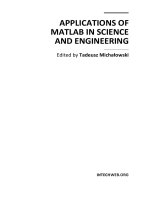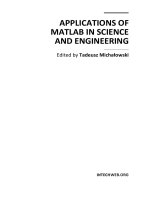MATHEMATICAL METHOD IN SCIENCE AND ENGINEERING Episode 8 pps
Bạn đang xem bản rút gọn của tài liệu. Xem và tải ngay bản đầy đủ của tài liệu tại đây (3.15 MB, 40 trang )
GROUP INVARIANTS
233
We can write this
as
For
a
linear transformation between
(Z,
g)
and
(z,
y)
we write
[;I=[:
:][;I-
Invariance of
(x2
-
y2>
can now be expressed
as
(11.55)
(11.56)
(11.57)
a2-c2 ab-cd
=Iz
'][ab-cd bz-d2][;]
2
=x
-y?
From
above we
see
that for
(z2
-
y')
to remain invariant under the transfor-
mation [Eq.
(1 1.56)],
components of the transformation matrix must satisfy
(11.58)
This means that only one of
(a, b, c,
d)
can be independent. Defining
a
new
parameter
x
as
a
=
coshx,
(
1
1.59)
we see that the transformation matrix in Equation
(11.56)
can be written
as
sinhx coshx
I
'
coshx sinhx
Introducing
cosh
x
=
y
sinhx
=
-70
tanh
x
=
-0,
(11.60)
(11.61)
(1 1.62)
(1 1.63)
234
CONTINUOUS GROUPS AND REPRESENTATIONS
where
along with the identification
x=ct
Y
=
X?
we obtain
[;I=[
-Pr
7
-"][:I
r
(1
1.64)
This is nothing but the Lorentz transformation
[Eqs.
(10.252-10.255):
(11.65)
-
1
(ct
-
wx/c)
ct=
dw
which leaves distances in spacetime, that is,
(CV
-
XZ)
,
(11.66)
(11.67)
(11.68)
invariant.
11.5
UNITARY GROUP IN
TWO
DIMENSIONS:
u(2)
Quantum mechanics is formulated in complex space. Hence the components
of
the transformation matrix
are
in general complex numbers. The scalar
or
inner product
of
two vectors in mdimensional complex space
is
defined
as
(
1
1.69)
(x,
Y>
=
x;y1
+
x;?&
+
.
.
.
+
x*y
n
n7
where
x*
means the complex conjugate
of
x.
Unitary transformations are
linear transformations, which leaves
(1 1.70)
invariant. All such transformations form the unitary
group
U(n).
An element
of
U(2)
can
be
written
as
2
(x,
x)
=
1x1
=
.;XI
+
4.2
+
.
.
.
+
x;zn
AB
u=[.
D],
(11.71)
UNITARY GROUPIN
TWO
DIMENSIONS:
u(2)
235
where
A,
B,
C,
and
D
are
in general complex numbers. Invariance
of
(x,
x)
gives the unitarity condition
as
utu
=
uut
=
I
,
(11.72)
where
ut
=
:*
(1
1.73)
is
called
the Hermitian conjugate
of
u.
Using the unitarity condition
we
can
write
which gives
A*
C"
AB
utu=[
B*
.*I.[
C
D]
IAI2
+
ICI2
A'B
+
C*D
]
=
[
AB*
+
D'C
[BI2+
IDI2
[AI2
+
ICI2
=
1
[BI2
+
1Ol2
=
1
A"B
+
C*D
=
0
(1 1.74)
(1 1.75)
(1 1.76)
(11.77)
From elementary matrix theory
(Boas),
the inverse
of
u
can be found
as
(11.78)
Because
for
SU(2)
the inverse
of
u
is
also
equal to
ut,
we write
u-1=
,t
(1
1.79)
[
-;
-f
]
=
[
,":
;:
]
This gives
D
=
A*
and
C
=
-B*;
thus
u
becomes
(
1
1.80)
(1
1.81)
Taking the determinant
of
the unitarity condition
[Eq.
(11.71)]
and using the
fact
that
det
ut
=
det
u,
we obtain
(1 1.82)
ldetul
2
=
1
.
236
CONTINUOUS GROUPS AND REPRESENTATIONS
11.6 SPECIAL
UNITARY
GROUP
su(2)
In quantum mechanics
we
are particularly interested in SU(2), a subgroup
of
U(2), where the
group
elements satisfy the condition
det
u
=
1.
For
SU(2),
A
and
B
in the transformation matrix
(11.83)
(1
1.84)
satisfy
(11.85)
detu=(A(
2
+IBI2=
1.
Expressing
A
and
l3
as
A=a+id
B
=
c+ib,
we
see
that the unitary matrix has the form
1
u=[
a+zd
c+ib
-c+ib
a-id
(11.86)
(
1
1.87)
(I
1.88)
This can be written
as
where
o,
are the Pauli spin matrices:
which satisfy
(1
1.91)
(1
1.92)
where
(i,
j,
k)
are cyclic permutations of (1,2,3). Condition (11.83) on the
determinant
u
gives
+
b2
+
c2
+
d2
=
1.
This allows
us
to choose
(a,
6,
c,
d)
as
(11.93)
u
=
cos
w,
b2
+
c2
+
d2
=
sin2
w,
(1
1.94)
LIE
ALGEBRA
OF
su(2)
237
thus Equation (11.89) becomes
u(w)
=
Icosw+iSsinw,
where
we
have defined
s
=a01
+
pa2
+
yo3
and
Note
that
u
in
(1 1.95)
(1 1.96)
(1
1.97)
;quation (11.71) has in general eight parameters.
Iowever,
among these eight parameters we have five relations,
four
of which come from
the unitarity condition (11.72). We also have the condition fixing the value
of the determinant (11.83) for
SU(2);
thus
SU(2)
can only have three in-
dependent parameters. These parameters can be represented by a point on
the three-dimensional surface (S-3)
of
a unit hypersphere defined by Equation
(11.93). In Equation (11.95)
we
represent the elements of SU(2) in terms of
w7
and
(a,
P,
7)
7
(1 1.98)
where
(a,
P,
y)
satisfies
a2+p+y2=
1. (1 1.99)
(1 1.
loo)
By changing
(a,
p,
y)
on S-3 we can vary
w
in
-
u(w)
=
I
cos
w+X
sin
w,
where
we
have defined
-
x
=
is,
hence
-
x2
=
432.
(1
1.101)
(1
1.102)
11.7
LIE ALGEBRA
OF
su(2)
In the previous section we have seen that the elements
of
the SU(2) group
are given as
-
u(w)
=
I
cos
w+X
sin
w.
(11.103)
238
CONTINUOUS GROUPS AND REPRESENTATIONS
The 2
x
2 transformation matrix, u(w), transforms complex vectors
v=[
Ir:]
(
1
1.104)
as
(1
1.105)
Infinitesimal transformations
of
SU(2), analogous
to
R(3), can
be
written
as
-
v
=
u(w)v.
v(w)
=
(I+XGw)v(O)
sv
=
Xv(0)sw
v’(w)
=
%v(O),
(11.106)
(11.107)
(1
1.108)
where the generator
X
is obtained in terms
of
the generators
XI,
%2,
%3
as
I
x
=
u’(0)
=
is
(1 1.109)
(1
1.1
lo)
x,=
-
[;
g],
xa=
-
01
o],
x3=
[;
3
(11.111)
-
X,
satisfy the following commutation relation:
-
x,,xj
=
-2EykXk.
(
1
1.1
12)
[-
-1
For
R(3)
we have seen that the generators satisfy Ekluation (11.15)
[x,,xj]
=
-CtjkXk,
(11.113)
and the exponential form
of
the transformation matrix for finite rotations was
[Eq.
(11.24)]
r(t)
=
ex
”r(0).
(11.114)
If
we
make the correspondence
-
2x2
c-$
xi,
(
1 1.1
15)
11E
ALGEBRA
OF
su(2)
239
the two algebras are identical and the groups SU(2) and R(3) are called
isomorphic.
Defining
a
unit normal vector
i3
=
(a,P,y),
(
1
1.1 16)
we can now use Equation (11.114) to write the exponential form of the trans-
formation matrix
for
finite rotations in SU(2)
as
-
v(t)
=
e+X.'ev(0).
(1
1.117)
Since
-
x=is,
(1
1.118)
This gives us the exponential form
of
the transformation matrix for SU(2)
as
v(t)
=
'Qv(~).
(11.119)
In quantum mechanics the active view, where the vector is rotated coun-
terclockwise,
is
preferred; thus the operator is taken
as
1
(
1
1.120)
,-+is
;ie
where
S
corresponds to the spin angular momentum operator.
s
=a01
+
002
+
703.
(11.121)
In Section 11.13 we will see that the presence of the factor 1/2 in operator
(10.120) is very important and it actually indicates that the correspondence
between SU(2) and
R(3)
is two-to-one.
11.7.1
Another Approach to
.Su(2)
Using the generators (11.111) and (11.103) we can write
-
x
=
ax1
+px2
+yx
(11.122)
and
u(a,
p,
y)
=
(I
cos
w+X
sin
w)
cos
w
+
iy
sin
w
(-0
+
ia)
sin
w
(1 1.123)
(1
1.124)
1-
(/3
+
ia)
sin
w
cos
w
-
iy
sin
w
The transformation
(11.125)
-
v
=
u(w)v
240
CONTINUOUS GROUPS AND REPRESENTATIONS
induces the following change in
a
function
f(v1,
~2):
-
f(V)
=
f
Mff,
P,
Y)VI'
(1 1.126)
Taking
the
active view we define an operator
0,
which acts on
f(v).
Since
both views should agree, we write
OfW
=
7(.)
(11.127)
(
11.128)
(11.129)
=
f
[u-l(ff,
0,
r,r]
=
f
[U(-ff,
-P,
-7)rI.
For
a
given small
w
we can write
u(-a,
-p,
-7)
in terms of
a,
p,
y
as
I
1
-
iyw
(p
-
iff)w
(-p
-
iff)w
1
+
iyw
i
4
-
ff,
-P,
-7)
=
(1
1.130)
Thus we obtain
-
v1
=
(1
-
iyw)v]
+
(-p
-
iff)wvz
(11.131)
(11.132)
-
ug
=
(p
-
iff)wv1
+
(1
+
iyLJ)v2.
Writing
Svi
=
Vi
-
vi
this becomes
sv1
=
-2ywVlf
(-p
-
iff)wv2
sv2
=
(p
-
icu)wvl
+
iywv2.
(
11.133)
(11.134)
We now write the effect of the operator
01,
which induces infinitesimal
changes in
a
function
f(vl,v2)
as
This
gives
the generator
01
as
(
11.136)
Similarly, we write
LORENTZ
GROUP
AND
ITS LIE ALGEBRA
241
and
These
give
us
the remaining generators
as
and
(11.138)
(11.139)
(11.140)
Oi
satisfy the commutation relation
[Oi,
Oj]
=
2ti3kOk
.
(11.141)
The sign difference with Equation
(11.112)
is again due
to
the fact that in
the passive view axes are rotated counterclockwise, while in the active view
vectors
are
rotated clockwise.
11.8
LORENTZ GROUP AND
ITS
LIE
ALGEBRA
The ensemble
of
objects
[a;],
which preserve the length
of
four-vectors in
Minkowski spacetime and which satisfy the relation
!?ff0a7a6
a
0-
-
976,
(11.142)
form the
Lorentz group.
If we exclude reflections and consider only the
transformations that can
be
continuously generated from the identity trans-
formation we have the
homogeneous Lorentz group.
The group that
includes reflections
as
well
as
the translations is called the
inhomogeneous
Lorentz group
or
the
Poincare group.
From now on we consider the
homogeneous Lorentz
group
and omit the word homogeneous.
Given the coordinates
of
the position four-vector
xa
in the
K
frame,
ele-
ments
of
the Lorentz group,
,
give
us
the components,
To,
in the
fi;
frame
as
a
x
=a;zP.
(11.143)
242
CONTINUOUS GROUPS AND REPRESENTATIONS
In matrix notation we can write this
as
X=
AX,
(1
1.144)
where
For transformations preserving the magnitude
of
four-vectors we write
I
(
1
I.
146)
and after substituting Equation (11.144) we obtain the analogue of the
or-
thogonality condition
as
xgx
=
xgx,
-
AgA
=
g.
(11.147)
Elements
of
the Lorentz group
are
4
x
4
matrices, which means they have 16
components. From the orthogonality condition (11.147), which
is
a
symmetric
matrix, we have
10
relations among these 16 components; thus only 6 of them
are independent. In other words, the Lorentz group is
a
six-parameter
group.
These six parameters can
be
conveniently thought of
as
the three Euler angles
specifying the orientation of the spatial axis and the three components
of
p
specifying the relative velocity
of
the two inertial frames.
Guided by our experience with
R(3),
to find the generators
of
the Lorentz
group we start with the ansatz that
A
can be written in exponential form
as
A
=
8,
(1 1.148)
where
L
is
a
4
x
4 matrix. From the theory of matrices we can write (Gant-
macher)
-+
det
A
=
det
eL
=
eTrL
.
(11.149)
Using this equation and considering only the proper Lorentz transformations,
where det
A
=1,
we conclude that
L
is traceless. Thus the generator
of
the
proper Lorentz transformations
is
a
real 4
x
4
traceless matrix.
We now multiply Equation (11.147) from the left by
gpl
and from the right
by
A-'
to write
g-lzg
[AA-'I
=
g-'gA-',
(
11.150)
which gives
-
g-'Ag
=
Ap'.
(11.151)
LORENTZ GROUP AND
ITS
LIE ALGEBRA
243
Since for the Minkowski metric
g-l=g,
(11.152)
this becomes
-
gAg
=
A ’.
(11.153)
Using Equation (11.153) and the relations g2
=
I,
A
=
eL,
and
A-l
=
ecL
we
can
also
write
-
-
gAg
=
egLg
=
ePL;
(11.154)
thus
-
gLg
=
-
L.
(11.155)
Since
=
g
we obtain
-
gL
=
-gL.
(1 1.156)
This equation shows that
gL
is an antisymmetric matrix. Considering that
g
is the Minkowski metric and
L
is traceless, we can write the general form
of
L
as
(11.157)
I-
0
-LO1
-LO2 -LO3
-hl
0
‘512 L13
-LO2
-Ll2
0
L23
-LO3 -L13
-L23
0
L=
1
Introducing six independent parameters
(PI,
02, j33) and
(01,
02,
03), this can
also
be
written
as
L
=
PiV1
+
P2V2
+
P3V3
+&XI
+
02x2
+
03x3,
(11.158)
where
-1
0 0
0
0-10
0
00-1
0
00
0
-100
0
(11.159)
and
00
0 0 000
0
00 0
0
000-1
0
0 0
-1
0
01
1
,x2=
[:;:
:I.”-
0-100.
0 0
00
(11.160)
244
CONTINUOUS GROUPS AND REPRESENTATIONS
x’
Fig.
11.3
Boost
and
boost
plus
rotation
Note that
(XI, Xz, X3)
are the generators of the infinitesimal rotations about
the
d-,
z2-,
z3-axes
[Eq.
(10.84)],
respectively, and
(Vl,Vz,V3)
are the
generators
of
the infinitesimal Lorentz transformations or
boosts
from one
inertial observer to another moving with respect to each other with velocities
(Pl,pz,
p3)
along the
d-,
z2-,
z3-axes,
respectively.
These six generators
satisfy the commutation relations
(11.161)
(11.162)
(11.163)
The first of these three commutators
is
just the commutation relation for the
rotation group
R(3);
thus the rotation group is
also
a
subgroup of the Lorentz
group. The second commutator shows that
Vi
transforms under rotation
like
a
vector. The third commutator indicates that boosts in general
do
not
commute, but more important than this, two successive boosts is equal to
a
boost plus
a
rotation (Fig.
11.3),
that
is,
Thus boosts alone
do
not form
a
group. An important kinematic consequence
of this is known
as
the Thomas precession.
We now define two unit bvectors:
(11.165)
LORENTZ GROUP AND ITS LIE ALGEBRA
245
and
and introduce the parameters
(1
1.166)
8=
vf8:+8;+8,2
and
(11.167)
(1
1.168)
so
that we
can
summarize these results
as
L
=
X.68
+
v-pp
(11.169)
and
A
=
,X ii6-1-V
(1
1.170)
For
pure rotations this reduces
to
the rotation matrix in Equation (11.24)
,X
ii6
Ad.
=
For
pure boosts it
is
equal to Equation (10.276)
Aboost(P)
=
ev
BS
(11.171)
- -
where
(11.172)
211
212
v2
PI
=
-,
02
=
-,
02
=
C
C C
For
a
boost
along the xldirection
P2
=
P3
=
0
and
,#
=
PI,
thus Equation
(11.172) reduces to
Y
-PY
0
0
(11.173)
AbOOst(P1)=
[
-Pr
;
Y
;
0
0
y
1
.
246
CONTINUOUS GROUPS AND REPRESEN JAJIONS
Using the parametrization
-PI
=
tanhx
y
=
cosh
x
-y&
=
sinhx
(
11.174)
(
11.175)
(
11.176)
Equation (11.173) becomes
(
11.177)
coshx sinhx
0 0
Aboost(fil)=[
sinhx
;
coshx
;
0
;
0
;],
which is reminiscent
of
the rotation matrices
[Eqs.
(10.42-43)]
with hyper-
bolic functions instead
of
the trigonometric. Notice that in accordance with
our previous treatment in Section 11.2, the generator
V1
can also
be
obtained
from
Vl
=
AL(P1
=
0).
(11.178)
The other generators can also
be
obtained similarly.
1
1.9
G
RO
U
P
REP R
ES
E
N
TAT
10
N
S
As
defined in Section
11.1,
a group with its general element shown with
g
is an
abstract concept. It gains practical meaning only when
G
is assigned physical
operations,
D(g),
to its elements that act in some space
of
objects called the
representation space.
These objects could
be
functions, vectors, and in
general tensors.
As
in the rotation group
R(3)
group representations can be
accomplished by assigning matrices
to
each element of
G,
which correspond to
rotation matrices acting on vectors. Given
a
particular representation
D(g),
another representation can be constructed by
a
similarity transformation
as
D'(g)
=
s-'D(g)s.
(
11.179)
Representations that are connected by
a
similarity transformation are called
equivalent representations.
Given two representations
D(')
(9)
and
D(2) (9)
we can construct another representation:
D(g)
=
Dqg)
€B
D(l)(g)
=
(
11.180)
where
D(g)
is called the product
of
D(')(g)
and
D(2)(g).
If
D(')(g)
has dimen-
sion
nl,
that
is,
composed
of
721
x
n1
matrices, and
D(2)(g)
has dimension
722,
the product representation has the dimension
n1
+
722.
D(g)
is
also
called
a
GROUP REPRESENTATIONS
247
reducible representation.
If
D(g)
cannot be split into the sums of smaller
representations by similarity transformations, it is called an
irreducible
rep-
resentation.
Irreducible representations are very important and they form
the building blocks
of
representation theory.
A
matrix that commutes with
every element
of
an irreducible representation is
a
multiple
of
the unit ma-
trix. We now present without proof an important lemma due to Schur for the
criterion
of
irreducibility of
a
group representation.
11.9.1
Schur's
Lemma
Let
D(')(g)
and
D(')(g)
be two irreducible representations with dimensions
n1
and
n2,
and suppose that
a
matrix
A
exists such that
AD(')(g)
=
D(2)(g)A
(11.181)
for all
g
in
G.
Then either
A
=
0,
or
n1
=
n2
and det
A
#
0,
and the two
representations
D(')
(g)
and
d2)
(9)
are equivalent.
By
a
similarity transformation if
D(g)
can be written
as
(
1
1.182)
we write
D(g)
=
D(')(g)
CB
2D(2)(g)
@
D(3)(g).
(11.183)
If
D(')(g), D(')(g),
and
D(3)(g)
cannot be reduced further, they are irreducible
and
D(g)
is
called
a
completely reducible representation.
Every group has
a
trivial one-dimensional representation, where each group
element
is
represented by the number one. In an irreducible representation,
say
D(2)(g)
as
in the above case, then every element of the representation space
is transformed into another element of that space by the action of the group el-
ements
D(')(g).
For
example, for the rotation
group
R(3)
a
three-dimensional
representation is given by the rotation matrices and the representation space
is
the Cartesian vectors. In other words, rotation
of
Cartesian vectors always
results in another Cartesian vector.
11.9.2 Group Character
The characterization
of
representations by explicitly giving the matrices that
represent the group elements
is
not possible, because by
a
similarity transfor-
mation one could obtain
a
different set of matrices.
Thus
we need
to
identify
properties that remain invariant under similarity transformations. One such
248
CONTINUOUS GROUPS AND REPRESENTATIONS
property is the trace of a matrix. We now define character
~(~)(g)
as
the trace
of the matrices
di)(g),
that is,
n;
(
11.184)
11.9.3
Unitary Representation
Representations of
a
group by unitary (transformation) matrices are called
unitary representations. Unitary transformations leave the quadratic form
invariant, which is equivalent to the inner product
n
(11.185)
(11.186)
in complex space.
11.10
REPRESENTATIONS
OF
R(3)
We now construct the representations of the rotation group. Using Cartesian
tensors
we
can easily construct the irreducible representations as
(11.187)
where
D(l)(g)
is the trivial representation, the number one, that acts on
scalars.
D(3)(g)
are given as the
3
x
3
rotation matrices that act on vec-
tors. The superscript
3
indicates the degrees
of
freedom, in this case the
three independent components of
a
vector.
D(5)(g)
is
the representation cor-
responding to the transformation matrices for the symmetric second-rank
Cartesian tensors. In this case the dimension of the representation comes
from the fact that a second-rank symmetric tensor has six independent com-
ponents; removing the trace leaves five. In general
a
symmetric tensor of rank
n
has
(2n+
1) independent components; thus the associated representation
is
(2n
+
1)-dimensional.
SPHERlCAL HARMONICS AND REPRESENTATIONS
OF
R(3)
249
11.11
SPHERICAL HARMONICS AND REPRESENTATIONS
OF
R(3)
An elegant and also useful way
of
obtaining representations of
R(3)
is to con-
struct them through the transformation properties
of
the spherical harmon-
ics. The trivial representation
D(’)(g)
simply consists
of
the transformation
of
Yo0
onto itself.
d3)(g)
describes the transformations
of
ql=1)m(Q,4).
The
three spherical harmonics
(Yl-
1,
Y~o,
Y11)
under rotations transform into lin-
ear combinations
of
each other. In general, the transformation properties
of
the (2l+ 1) components of
x,(e,
4)
generate the irreducible representations
D(21+1)(g)
of R(3).
11.11.1
In quantum mechanics angular momentum,
L,
is
a differential operator acting
on a wave function
q(x,
y,
2).
It is obtained from the classical expression for
the angular momentum,
Angular Momentum
in
Quantum Mechanics
+
L=?;’xT,
(11.188)
by replacing position and momentum with their operator counterparts, that
is,
?+?,
as
L
=
4i-P
x
a‘.
(11.189)
(1 1,190)
Writing
L
in Cartesian coordinates we find its components as (we
set
fi
=
1)
(1
1.191)
(1 1.192)
(1 1.193)
In Section 11.3.1
we
have seen that
xi
satisfy the commutation relation
pZi,Xj]
=
EijklZk,
(11.194)
thus
Li
satisfy
[Li,
Lj]
=
ZGjkLk,
(1
1.195)
where the indices
i,
j
and
lc
take the values 1,2,3 and they correspond
to
x,
y,
z,
respectively.
250
CONTINUOUS
GROUPS
AND REPRESENTATIONS
Fig.
11.4
Counterclockwise rotation
of
the
physical system by
6,
about
fi
11.11.2
Rotation
of
the Physical System
We have seen that the effect
of
the operator [Eq.(11.40)]
-
(
1
I.
196)
,-x
he,
is to rotate
a
function clockwise about an axis pointing in the
fi
direction by
On.
In quantum mechanics
we
adhere to the right-handed screw convention,
that
is,
when we curl the fingers
of
our
right hand about the axis
of
rotation
and in the direction
of
rotation, our thumb points along
fi.
Hence we work
with the operator
-
>
(11.197)
,x
fie,
which rotates
a
function counterclockwise
by
8,
(Fig. 11.4).
Using
Equations
(11.191-11.193) the quantum mechanical counterpart
of
the rotation operator
now becomes
R
=e-iL
66,
(
11.198)
For
a
rotation about the z-axis this gives
R9(r,6,4)
=
[e-iLzd]
@(T,
8,4).
(11.199)
R@(z,Y,z)
=
e-iL6en@(z,y,z). (11.2oo)
For
a
general rotation about an axis in the
fi
direction by
8,
we write
SPHERICAL HARMONICS AND REPRESENTATIONS
OF R(3)
251
11.11.3
Using the Euler angles we can write the rotation operator
Rotation Operator in Terms
of
the Euler Angles
R
=e-i~
iie,
f
(11.201)
(11.202)
In this expression we have used another convention commonly used in modern-
day quantum mechanical discussions
of
angular momentum. It is composed
of
the sequence
of
rotations, which starts with
a
counterclockwise rotation by
Q
about the z-axis of the initial state of the system:
e-ioL,
:
(GY,
z>
-+
(zl,YI,zl).
(1 1.203)
about
y1
of the interme
This is followed by
a
counterclockwise rotation by
diate axis
as
e-ipLyl:
(z1,y1,z1)
+
(Z2,Y2,Z2).
(
1
1.204)
Finally the desired orientation is reached by
a
counterclockwise rotation about
the q-axis by
y
as
e-i7Lz,
~
(z2,y2,
z2)
t
(z’,
Y’,
2’).
(1
1.205)
11.11.4
One of the disadvantages
of
the rotation operator expressed
as
Rotation Operator in Terms
of
the Original Coordinates
(1
1.206)
R
=e-
iL.;ie,
- -
e-
iy~,,
e-
ip~,,
e-ia~z
is that, except for the initial rotation about the z-axis, the remaining two
rotations are performed about different sets of axis. Because we are interested
in evaluating
RWz,y,
z)
=
WZ’,Y’,
4,
(
1
1.207)
where
(z,
y,
z)
and
(z’,
y’,
z’)
are two points in the same coordinate system,
we need to express
R
as
rotations entirely in terms of the original coordinate
axis.
For
this we first need to find how the operator
R
transforms under co-
ordinate transformations. We now transform to
a
new coordinate system
(zn,
yn,
zn),
where the +axis is aligned with the
fi
direction. We show the
matrix
of
this coordinate transformation with the letter
R.
We are interested
in expressing the operator
R
in terms of the
(z~,
yn,
zn)
coordinates. Action
of
R
on the coordinates induces the following change in
@(z,
y,
z)
:
252
CONTINUOUS GROUPS AND REPRESENTATIONS
Fig.
11.5
Transformation to the
(z,,
g,,
2,)-axis
Similarly for another point we write
R@(z’,
y’,
z’)
=
\k(z;,
y;,
zk).
Inverse transformations
are
naturally given
as
(Fig. 11.5)
R-l*(z,,ym,zn)
=
@(z,y,z)
R-’*(z;,y;,z;)
=
@(z’,y’,z/).
RR-’*(~,,y,,zn)
=
RQ(z,y,z).
and
Operating on Equation (11.210) with
R
we get
Using Equation (11.207), this becomes
We now operate on this with
R
to get
where
(11.209)
(11.210)
(11.211)
(11.212)
(11.213)
(11.214)
(
1
1.2 15)
( 11.2
16)
SPHERICAL HARMONICS AND REPRESENTATIONS
OF R(3)
253
We now observe that (This may take
a
while to convince oneself. We recom-
mend that the reader first plot all the axes in Equations
(11.203)
to
(11.205)
and then, operate on a radial vector drawn from the origin with
(11.217).
Finally, trace the orbit of the tip separately for each rotation while preserving
the order
of
rotations.)
e-iYLz,
=
e-iPLy, e-i7L,1 eiPLyl
(
11
217)
to write
R
,e-iPLgl e-i’YLzl [eiPLyl e-iPLgl] e-iaLz.
(
11
218)
The operator inside the square brackets is the identity operator; thus
R
,e-iPLgl e-i7Lz1e-iaL~
(1
1.219)
We now note the transformation
e-
iPL,,
=
e-
iaL,
e
iPLY eiaL,
(1
1.220)
to write
(1 1.221)
R
=e-iaL~ e-iPLyeiaL.e-i’YL.l e-iaL,
Since
z1
=
z,
this becomes
(11.222)
R
,e-iaLze-iflLy
[
iaLze-iaL,
]
e-iyL,-
Again the operator inside the square brackets is the identity operator, thus
giving
R
entirely in terms
of
the original coordinate system
(x, y,
z)
as
(11.223)
R
=e-i0.L,e-i0Lye-i7Lz
We can now find the effect of
R(a7
P,
y)
on
@(z,
y,
z)
as
R(a,P,y)qz,!Az)
=
Wx’,Y’,z’)
(
1
1.224)
e-iaL,e-iPLye-i7L,
\[I
(
,Y,Z)
=
Wz’,y’,z’).
In spherical polar coordinates this becomes
R(a,
P7
Y)W,
0,
$1
=
w-,
8,’
4’).
(1 1.225)
Expressing the components of the angular momentum operator in spherical
polar coordinates:
x
+
zy
=
r
sin
&+a6
and
z
=
rcosf?,
(1
1.226)
254
CONTINUOUS GROUPS AND REPRESENTATIONS
Y’
Fig.
11.6
(z,y,z)
and the
(z‘,y’,z‘)
coordinates
we obtain (Fig. 11.6)
L,=
(1
1.227)
d
icotOsin4-
84
a a
ae
34
L*
=
L,
*
ZL,
=
e*;q*-
+
icot
0-),
L2
=
L:
+
L;
+
Lq
(11.228)
(11.229)
(11.230)
(11.231)
Using Equations (11.227-11.229) we can now write Equation (11.224) as
which is now
ready
for applications to spherical harmonics
&(O,
4).
SPHERICAL HARMONICS AND REPRESENTATIONS
OF
R(3)
255
11.11.5
In Chapter
9
we have established the following eigenvalue equations [Eqs.
(9.172-173)
and
(9.187-188)]:
Eigenvalue Equations
for
L,,
Lk,
and
L2
LzKm(Q,
4)
=
mXm(Q7
4)>
L-K,(Q,~)
=
J(i+m)(i
-m+
1)x,m-1(Q74)7
L+xm(Q,
4)
=
JQ
-
m)(i+
m
+
l)x,m+l(~,
417
L2Km(@,
4)
=
1(1+
1)Xm(Q,
4).
(11.233)
(11.234)
(11.235)
(11.236)
Using these and the definition
L*
=
L,
*
zLy
we can also write
(11.237)
11.11.6
We
can expand
a
sufficiently smooth function,
F(B,
@)7
in terms of spherical
harmonics, which forms
a
complete and orthonormal set
as
Generalized Fourier Expansion in Spherical Harmonics
co
m‘=l’
F(o,4)
=
C C
CL~~IK(~~(Q,
4)7
(
1
1.239)
l’=O
m’=-
1’
where the expansion coefficients are given
as
cL’mt
=
/
/
dQqfml
(@7
4)F(B7
4)-
Spherical harmonics satisfy the orthogonality relation
1
1
dQY,:,,
(Q74)Km(Q,
4)
=
4P
fimmf
and the completeness relation
(1 1.240)
(
1
1.24 1)
c c
Y,L(Q’,4’)Km(B,4)
=
G(cosQ-cosQ’)6(4-4’),
I=O
m=-I
(11.242)
where
dQ
=
sin
Qdsdq5.
In the study of angular momentum in quantum physics
we frequently need expansions of expressions like
&z(Q,
4)
=
f(Q7
4>Xm(Q7
4)
(1 1.243)
256
CONTINUOUS GROUPS AND REPRESENTATIONS
and
(11.244)
aa
Glrn(e,4)
=
o(-
-,Q,4)Krn(Q,4),
a6
'
a4
where
O($,
&,
8,4)
is some differential operator.
For
&,(6,4)
we can write
For
Gtrn(6,4)
we can write
where
Based on these we can also write the expansion
(11.250)
(11.252)
where
SPHERICAL HARMONICS AND REPRESENTATIONS
OF
R(3)
257
11.11.7
Using the result [Eq. (11.249)] of the previous section we can now evaluate
LyY(l=I)rn
as
Matrix Elements
of
L,,
Ly,
and
5,
m'=l
Lyql=l)m
=
C
C~fnz~,(l=l)mK~ml(Q,
4)-
This gives the following matrix elements for the angular momentum operator
Ly(l
=
1)
as
(11.254)
m'=
-
1
(Kl=1mt,
LyX=Im)
=
Cf'=lm',t=lm
(
1
1.255)
=
//
XLlm{(Q,
4)LyK=lm(Q,
4).
We have dropped brackets in the
1
indices. We now use Equation (11.238):
to write
(1 1.257)
Operating on Equation (11.254) with
Ly
and using Equation (11.257)
we
can
write
m'=
1
L;K=lm
=
C
LyKf=lm/(Q,
4)
[~y(i
=
l)lmJm
(1
1.258)
m'=-
1
to obtain the matrix elements
of
Lz
as
[L;Q
=
1)lmrn,
(
1
1.259)
0
-5
0
0
1/2
0
-1/2
-1/2
0
1/2
=[
0
1
0
1.









